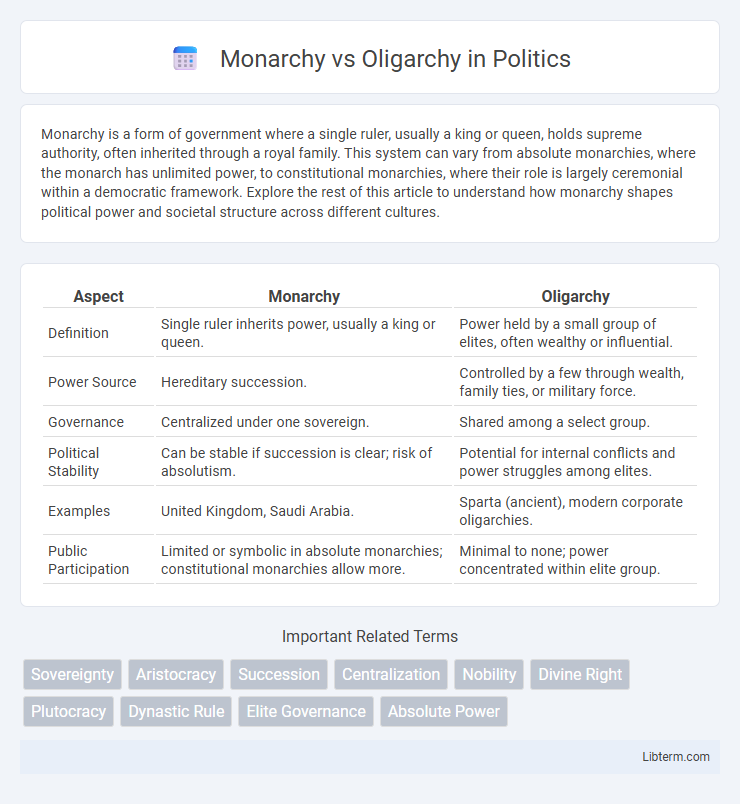Monarchy is a form of government where a single ruler, usually a king or queen, holds supreme authority, often inherited through a royal family. This system can vary from absolute monarchies, where the monarch has unlimited power, to constitutional monarchies, where their role is largely ceremonial within a democratic framework. Explore the rest of this article to understand how monarchy shapes political power and societal structure across different cultures.
Table of Comparison
| Aspect | Monarchy | Oligarchy |
|---|---|---|
| Definition | Single ruler inherits power, usually a king or queen. | Power held by a small group of elites, often wealthy or influential. |
| Power Source | Hereditary succession. | Controlled by a few through wealth, family ties, or military force. |
| Governance | Centralized under one sovereign. | Shared among a select group. |
| Political Stability | Can be stable if succession is clear; risk of absolutism. | Potential for internal conflicts and power struggles among elites. |
| Examples | United Kingdom, Saudi Arabia. | Sparta (ancient), modern corporate oligarchies. |
| Public Participation | Limited or symbolic in absolute monarchies; constitutional monarchies allow more. | Minimal to none; power concentrated within elite group. |
Introduction to Monarchy and Oligarchy
Monarchy is a form of government where a single individual, often a king or queen, holds supreme authority, typically inherited through a royal family lineage. Oligarchy concentrates power in the hands of a small group of people, such as wealthy elites or influential families, who govern based on their collective interests. Both systems differ significantly in power distribution, with monarchy centralizing control in one ruler, while oligarchy disperses it among a select few.
Defining Monarchy: Key Characteristics
Monarchy is a political system where a single ruler, often hereditary, holds supreme authority over the state, typically embodied in the figure of a king or queen. This centralized power is usually maintained through established traditions, legal frameworks, or divine right, distinguishing it from other forms of governance. Monarchical power can be absolute or constitutional, with the latter sharing authority with elected bodies or legal statutes.
Understanding Oligarchy: Core Features
Oligarchy is a form of governance where power is concentrated in the hands of a small group of individuals, often distinguished by wealth, family ties, or military control. This elite group makes decisions that primarily benefit their own interests, limiting broader public participation in political processes. Unlike monarchy, which centralizes authority in a single ruler, oligarchy distributes power among a few, often creating a system characterized by exclusivity and limited accountability.
Historical Evolution of Monarchical Systems
Monarchical systems have evolved from absolute rule by kings or queens, often justified by divine right, to constitutional monarchies that limit royal power through legal frameworks. Historical developments such as the Magna Carta in England and the Glorious Revolution significantly curtailed monarchical authority, transitioning governance towards parliamentary democracy. This evolution contrasts with oligarchies, where power remains concentrated in a small group without hereditary succession, highlighting distinct pathways in political power distribution.
The Rise and Influence of Oligarchies
Oligarchies rise when power consolidates among a small group of wealthy or influential individuals, often eclipsing the authority of traditional monarchs. Their influence expands through economic control, political alliances, and manipulation of state institutions, enabling them to shape policy and governance to serve elite interests. Historical examples include medieval Italian city-states and modern corporate-dominated governments, where oligarchies challenge or supplant monarchical structures.
Power Structure: Centralization vs. Collective Rule
Monarchy features a centralized power structure where a single ruler, often a king or queen, holds supreme authority and decision-making power. In contrast, oligarchy disperses power among a small group of elites or influential families, enabling collective rule and shared governance. The centralization in monarchy often results in swift policy implementation, while oligarchy promotes power balance but may lead to slower consensus-building.
Governance Efficiency: Monarchy vs Oligarchy
Monarchy often enables quicker decision-making due to centralized authority vested in a single ruler, streamlining governance processes. Oligarchy disperses power among a small group, which can lead to slower decisions but allows for diverse input in policymaking. Efficiency in governance depends on the leadership quality and institutional structures rather than the system itself.
Societal Impact and Public Participation
Monarchy often centralizes power in a single ruler, limiting public participation and concentrating decision-making, which can lead to societal stability but risks authoritarianism. Oligarchy distributes control among a small elite group, often reducing broader societal involvement and fostering inequality, impacting social mobility and collective governance. Public participation is generally restricted in both systems, hindering democratic engagement and potentially increasing social stratification.
Modern Examples and Contemporary Relevance
Modern monarchies, such as Saudi Arabia and the United Kingdom, maintain distinct governance structures with varying degrees of political power concentrated in a single ruler or a royal family. Contemporary oligarchies, exemplified by Russia and China, feature rule by a small group of elites controlling political and economic resources, influencing policy decisions behind formal governmental institutions. The relevance of these systems lies in their impact on political stability, economic development, and citizen participation within global frameworks emphasizing democracy and human rights.
Conclusion: Comparing Monarchy and Oligarchy
Monarchy centralizes power in the hands of a single ruler, often ensuring swift decision-making but risking authoritarianism. Oligarchy distributes control among a select few, which can promote stability yet may lead to elitism and limited public input. Both systems prioritize concentrated authority but differ in power distribution and potential for inclusivity.
Monarchy Infographic

 libterm.com
libterm.com